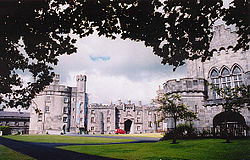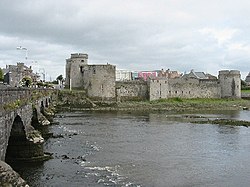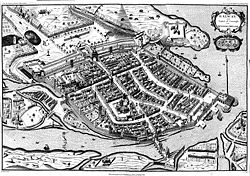Cromwellian conquest of Ireland
During the wars of the kingdoms, forces of the English parliament conquered Ireland, between 1649 and 1653. These forces were led by Oliver Cromwell. The event is known as Cromwellian conquest of Ireland or Cromwellian war in Ireland. Cromwell invaded Ireland with his New Model Army on behalf of England's Rump Parliament in August 1649.
| Cromwellian conquest of Ireland | |||||||
|---|---|---|---|---|---|---|---|
| Part of the Eleven Years' War and Wars of the Three Kingdoms | |||||||
 Oliver Cromwell, who landed in Ireland in 1649 to re-conquer the country on behalf of the English Parliament. He left in 1650, having taken eastern and southern Ireland, passing his command to Henry Ireton. | |||||||
| |||||||
| Belligerents | |||||||
|
| Protestant colonists | ||||||
| Commanders and leaders | |||||||
|
|
| ||||||
| Strength | |||||||
| Up to 60,000 incl. guerrilla fighters, but only around 20,000 at any one time |
~30,000 New Model Army troops, ~10,000 troops raised in Ireland or based there before campaign | ||||||
| Casualties and losses | |||||||
|
Unknown; 15,000–20,000 battlefield casualties, over 200,000–600,000 civilian casualties (from war-related violence, famine or disease)[1] ~50,000 deported as indentured labourers[2][3] |
8,000 New Model Army soldiers killed, ~7,000 locally raised soldiers killed | ||||||
After the Irish Rebellion of 1641, most of Ireland came under the control of the Irish Catholic Confederation. In early 1649, the Confederates allied with the English Royalists, who had been defeated by the Parliamentarians in the English Civil War. By May 1652, Cromwell's Parliamentarian army had defeated the Confederate and Royalist coalition in Ireland and occupied the country, ending the Irish Confederate Wars (or Eleven Years' War). However, guerrilla warfare continued for a further year. Cromwell passed a series of Penal Laws against Roman Catholics (the vast majority of the population) and confiscated large amounts of their land.
The Parliamentarian conquest was brutal, and Cromwell is still a hated figure in Ireland.[4] The extent to which Cromwell, who was in direct command for the first year of the campaign, was responsible for the atrocities is debated to this day. Some historians[5] argue that the actions of Cromwell were within the then-accepted rules of war, or were exaggerated or distorted by later propagandists; these claims have been challenged by others.[6]
The impact of the war on the Irish population was unquestionably severe, although there is no consensus as to the magnitude of the loss of life. The war resulted in famine,[7][8][9][10] which was worsened by an outbreak of bubonic plague. Estimates of the drop in the Irish population resulting from the Parliamentarian campaign range from 15 to 41 percent.[11] The Parliamentarians also transported about 50,000 people as indentured labourers.[2] Some estimates cover population losses over the course of the Conquest Period (1649–52) only,[12] while others cover the period of the Conquest to 1653 and the period of the Cromwellian Settlement from August 1652 to 1659 together.
Cromwellian Conquest Of Ireland Media
Kilkenny Castle. The Irish Confederate capital of Kilkenny fell to Cromwell in 1650.
Henry Ireton. Cromwell passed the command of Parliamentarian forces in Ireland to Ireton in 1650. He died of disease at the Siege of Limerick in 1651.
King John's Castle and Thomond Bridge, Limerick city. Ireton took Limerick in 1651 after a long siege.
The heavily fortified city of Galway in 1651. It was the last Irish stronghold to fall to the Parliamentarians, surrendering in 1652.
After Cromwell's victory, huge areas of land were confiscated and the Irish Catholics were banished to the lands of Connacht.
References
- ↑ Mícheál Ó Siochrú/RTÉ ONE, Cromwell in Ireland Part 2. Broadcast 16 September 2008.
- ↑ 2.0 2.1 O'Callaghan 2000, p. 85.
- ↑ Higman 1997, pp. 107,108.
- ↑ "Of all these doings in Cromwell's Irish Chapter, each of us may say what he will. Yet to everyone it will at least be intelligible how his name came to be hated in the tenacious heart of Ireland". John Morley, Biography of Oliver Cromwell. Page 298. 1900 and 2001. ISBN 978-1-4212-6707-4.; "Cromwell is still a hate figure in Ireland today because of the brutal effectiveness of his campaigns in Ireland. Of course, his victories in Ireland made him a hero in Protestant England." "Why did Britain become a republic?". Archived from the original on 28 September 2007. Retrieved 2009-05-25. British National Archives web site. Accessed March 2007; "1649-52: Cromwell's conquest of Ireland". Archived from the original on 11 December 2004. Retrieved 2006-01-17. From a history site dedicated to the English Civil War. "... making Cromwell's name into one of the most hated in Irish history". Accessed March 2007. Site currently offline. WayBack Machine holds archive here
- ↑ Philip McKeiver in his, 2007, A New History of Cromwell's Irish Campaign ISBN 978-0-9554663-0-4 and Tom Reilly, 1999, Cromwell: An Honourable Enemy ISBN 0-86322-250-1
- ↑ Coyle, Eugene (Winter 1999). "Cromwell: An Honourable Enemy, Tom Reilly [review of]". Book Reviews. History Ireland. 7 (4). Retrieved 10 October 2014.
- ↑ Prendergast, John Patrick (2 January 1868). The Cromwellian settlement of Ireland. P.M. Haverty – via Internet Archive.
- ↑ "Inventory of Conflict and Environment (ICE), Cromwell's Famine". mandalaprojects.com.
- ↑ "Historical Context - The Down Survey Project". downsurvey.tcd.ie.
- ↑ Padraig Lenihan, Confederate Catholics at War (2001) p112, 'As late as 1650, provisions were cheaper in Ireland than in England; the famine of 1651 onwards was a man made response to stubborn guerrilla warfare. Collective reprisals against the civilian population included forcing them out of designated no man's lands and the systematic destruction of foodstuffs'.
- ↑ 15–25%
- Padraig Lenihan, Confederate Catholics at War, p11250%:
- The History and Social Influence of the Potato, Redcliffe N. Salaman, Edited by JG Hawkes, 9780521316231, Cambridge University Press
- How many died during Cromwell’s campaign?41%:
- ↑ "Down Survey". Trinity College Dublin Department of History. Retrieved 19 March 2016.




